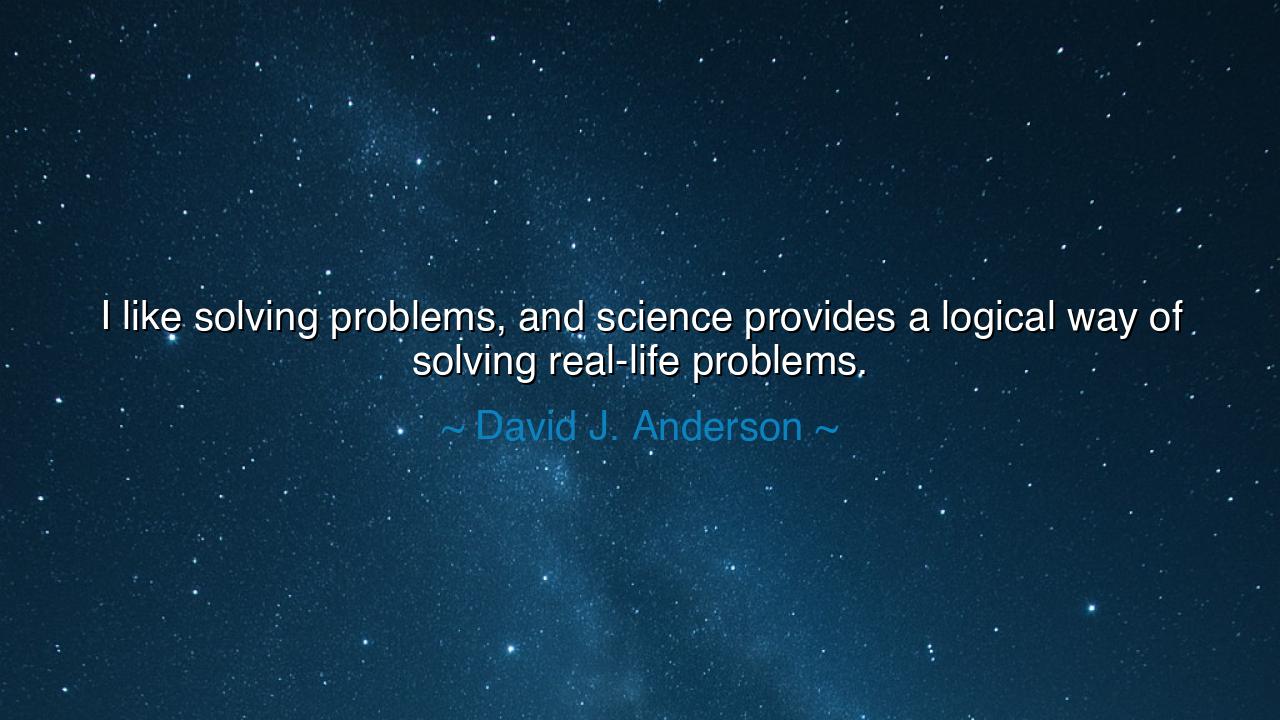
I like solving problems, and science provides a logical way of
I like solving problems, and science provides a logical way of solving real-life problems.






"I like solving problems, and science provides a logical way of solving real-life problems." These words from David J. Anderson capture the essence of what makes science not only a pursuit of knowledge but a tool for overcoming the challenges that confront humanity. Science, in Anderson's view, is more than an abstract realm of theory; it is a practical method by which we can address the issues that arise in our everyday lives. In this simple yet profound statement, we are reminded that science is not just an intellectual exercise but a means of understanding the world, of grappling with its complexities, and of finding solutions that make our lives better, safer, and more meaningful.
In the ancient world, the pursuit of knowledge was often driven by the same desire to solve the problems of human existence. The great Greek philosophers—figures like Socrates, Plato, and Aristotle—viewed science as the pathway to understanding not only the natural world but also the ethical and political structures that governed human life. Aristotle, for example, was deeply invested in studying nature, but he did so with a practical eye toward understanding how the natural world interacted with the human condition. His works on biology, ethics, and logic sought to solve the great problems of his time—questions about life, society, and the principles that underlie the universe. For the ancients, science was never just theoretical; it was meant to improve the quality of life, to address the real issues that humanity faced.
The same impulse that drove the ancient philosophers to seek solutions to life's greatest challenges is present in Anderson's words. He speaks not just of solving problems in the abstract but of using science as a logical method to address the practical difficulties that arise in the world. Take, for example, the story of Archimedes, one of the most brilliant minds of ancient Greece. Archimedes was not content with mere theoretical knowledge; he used his understanding of mathematics and physics to invent devices that could solve real-world problems. His invention of the Archimedean screw to pump water is one of the earliest examples of science being used as a tool to solve practical issues, demonstrating how scientific thinking can be applied to improve daily life. Archimedes, like Anderson, understood that science could be used to solve problems in a logical and methodical way.
Fast forward to the modern age, and the need for problem-solving through science has never been greater. Consider the scientific revolution of the 17th century, when thinkers like Galileo and Newton sought not just to describe the world but to understand its underlying principles. Newton's laws of motion, for instance, did not arise from mere curiosity; they were born out of a desire to solve the problem of understanding how forces act upon the world. Newton's work laid the foundation for much of modern physics, offering solutions to questions about motion, gravity, and mechanics. His approach was not one of speculation but of applying logical methods to solve the practical problems of understanding the universe.
Another powerful example of science solving real-life problems can be seen in the development of vaccines. In the 18th century, Edward Jenner, a country doctor, noticed that milkmaids who had contracted cowpox did not seem to get smallpox, a deadly disease that plagued the human population. Using this observation, Jenner devised a method to vaccinate people against smallpox, effectively using science to solve one of the greatest health problems of his time. This breakthrough in immunology was not merely an academic exercise but a practical solution to a deadly global issue. The logic of science, when applied with careful observation and reasoning, became a force that saved countless lives and changed the course of human history.
In the same way, we can look at the work of modern scientists like Marie Curie, whose discoveries in radioactivity paved the way for advancements in medical treatments like cancer therapy. Her work did not arise from a detached intellectual curiosity but from a deep desire to solve the problem of improving human health. The scientific method she employed, grounded in logic and experimentation, allowed her to find practical solutions to real problems, just as Anderson describes—science applied directly to improve the human condition.
The lesson, dear ones, is clear. Science is not a passive, detached pursuit. It is a tool—a method by which we can solve the pressing problems that face us, both in the world of nature and in the human experience. Megan Smith and David Anderson remind us that science is most powerful when it is used to address real, tangible problems, when it is guided by a desire to improve the lives of those who walk the earth. The true power of science lies not in the accumulation of knowledge alone but in the ability to apply that knowledge to solve real problems.
So, as you journey through life, remember that the pursuit of knowledge should always be connected to a greater purpose—the improvement of the world around you. Embrace science as a way to answer the questions of our time, but also as a way to solve the problems that need our attention. Whether you are an engineer, a doctor, a teacher, or simply a curious soul, let the power of science be your guide in solving the problems of the day. For it is in the logical application of knowledge—the scientific method—that we truly transform the world.






AAdministratorAdministrator
Welcome, honored guests. Please leave a comment, we will respond soon